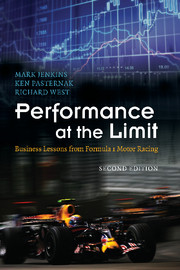Book contents
- Frontmatter
- Contents
- List of figures
- List of tables
- List of plates
- Acknowledgements
- Note on the reference system
- The Grand Prix experience
- 1 Introduction
- 2 Why Formula 1 motor racing?
- 3 The performance framework
- 4 The war for talent
- 5 Winning through teamwork
- 6 Capability through partnerships
- 7 The high-performance organisation
- 8 Integrating
- 9 Innovating
- 10 Transforming
- 11 Achieving and sustaining performance
- 12 Twelve business lessons from Formula 1 motor racing
- Appendix A Grand Prix Champions 1950–2008
- Appendix B Grand Prix Graveyard 1950–2008
- Appendix C Interview respondents
- References
- Index
- Plate section 1
- Plate section 2
7 - The high-performance organisation
Published online by Cambridge University Press: 05 August 2013
- Frontmatter
- Contents
- List of figures
- List of tables
- List of plates
- Acknowledgements
- Note on the reference system
- The Grand Prix experience
- 1 Introduction
- 2 Why Formula 1 motor racing?
- 3 The performance framework
- 4 The war for talent
- 5 Winning through teamwork
- 6 Capability through partnerships
- 7 The high-performance organisation
- 8 Integrating
- 9 Innovating
- 10 Transforming
- 11 Achieving and sustaining performance
- 12 Twelve business lessons from Formula 1 motor racing
- Appendix A Grand Prix Champions 1950–2008
- Appendix B Grand Prix Graveyard 1950–2008
- Appendix C Interview respondents
- References
- Index
- Plate section 1
- Plate section 2
Summary
It’s the informal organisation that runs things here. It’s the experienced people in the organisation who are empowered to get on and do things.
Alex Burns, COO, Williams F1In this chapter, we will look closely at high-performance organisations in the context of Formula 1 teams by responding to three questions: What business are Formula 1 teams in? Who are their customers? And, most crucially, how do they achieve high performance? This last question enables us to explore the key processes which lead to winning on the track – designing and manufacturing a competitive car, maintaining consistency and reliability, and generating revenue streams so they can keep racing.
What business is a Formula 1 team in?
From one perspective they are in the performance engineering business. They produce a small number of highly specialised vehicles over the space of a year, which they continually develop in order to achieve sustained performance levels. From this point of view, we can understand why the region around Oxford in the UK is referred to as Motorsport Valley, a comparison with Silicon Valley on the west coast of the US, where a local cluster of firms dominate the world in a particular technology, in the latter case micro-processors.
Information
- Type
- Chapter
- Information
- Performance at the LimitBusiness Lessons from Formula 1 Motor Racing, pp. 114 - 133Publisher: Cambridge University PressPrint publication year: 2009
